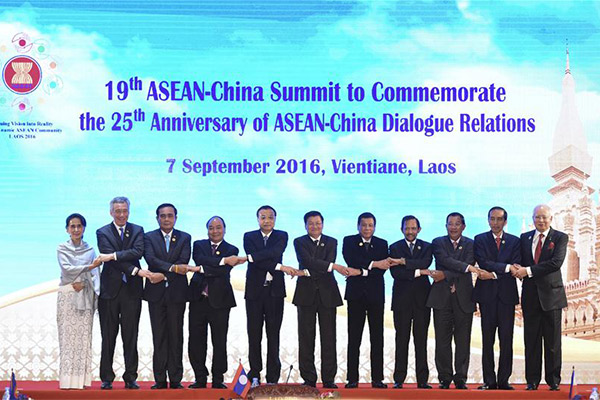
Premier Li Keqiang (5th L) attends the 19th summit between China and the Association of Southeast Asian Nations (ASEAN) to commemorate the 25th Anniversary of China-ASEAN Dialogue Relations, in Vientiane, Laos, Sept 7, 2016. [Photo/Xinhua]
BEIJING — At the East Asian leaders’ meetings that ended on Sept 8, China and most of the participating countries focused on the “big picture” of their cooperation on both economic growth and political security, without being distracted by a notorious arbitration of the South China Sea issue.
Some overseas media outlets commented that China has “scored a diplomatic victory” as the arbitration ruling has not been mentioned in the statements issued by the Southeast Asian countries after this series of meetings.
Actually, such a “diplomatic victory” reflects the common choice made by China and most of the ASEAN members: to work with concerted efforts to remove disturbances, and seek common development, mutual benefits and win-win results.
While addressing the East Asian Summit on Sept 8, Premier Li Keqiang described the East Asia region as a land “far from conflicts and a bonanza for trade and investment,” adding that such a desirable situation is hard-earned and should be treasured by all countries.
At the summit, the Premier also spelled out China’s stance on the South China Sea issue, saying that China and the ASEAN countries have found a way that not only reflects the rules of international law but also lead to “effective” management of disputes.
He also said that China and the ASEAN nations have the full wisdom and ability to address the South China Sea issue.
Premier Li’s speech, which is in line with the common aspiration of the people in the East Asian region, has won deep understanding and broad support of the participating countries.
In their speeches delivered at the summit, leaders of the ASEAN countries acknowledged the efforts made by China and the ASEAN members in implementing the Declaration on the Conduct of Parties in the South China Sea (DOC) and promoting the discussion of the Code of Conduct in the South China Sea (COC).
They spoke highly of the four outcome documents produced during the China-ASEAN leaders’ meetings, saying that China and the ASEAN countries are on their way to find a right path that leads to peace and stability in the South China Sea region as well as a proper solution to the issue.
“The limited scope of the agreement on Sept 7, which had been expected, reflected how Southeast Asian nations have largely moved on from the initial tensions surrounding The Hague tribunal’s ruling and now shifted their focus on ensuring regional stability,” said The Wall Street Journal in an article on Sept 7.
The ASEAN countries have learned that the key to solving the South China Sea issue should be held in their own hands and they should return to the channel of a complete and effective implementation of the Declaration on the Conduct of Parties in the South China Sea (DOC), said Vice Foreign Minister Liu Zhenmin on Sept 8.
Only strengthening cooperation and building mutual trust can safeguard East Asia’s peace and security and maintain its economic prosperity, Liu told a press briefing after the East Asia Summit.
Only two countries outside the region proposed to push the so-called South China Sea “arbitration” at the summit, which runs against the trend of solving disputes through dialogues and consultations, he said.
Instead of solving problems, such a meddling act can only expand differences and contradictions, he added.
The ASEAN countries did not respond to Washington’s remarks that regional powers should accept the so-called South China Sea arbitration results, nor did the ASEAN Declaration or other documents contain any unwarranted accusations against China, leaving the United States end up in an awkward situation.
History may remember the ASEAN event in Laos “as more as a pivot to China,” said Forbes magazine in an article on Sept 6.
Any attempt to reverse the trend of peace and development in East Asia is destined to fail. Whether major powers outside the region or one or two East Asian countries, they should come to realize the real situation in the area and change their way of thinking to get on well with China and the ASEAN countries for sincere cooperation.
